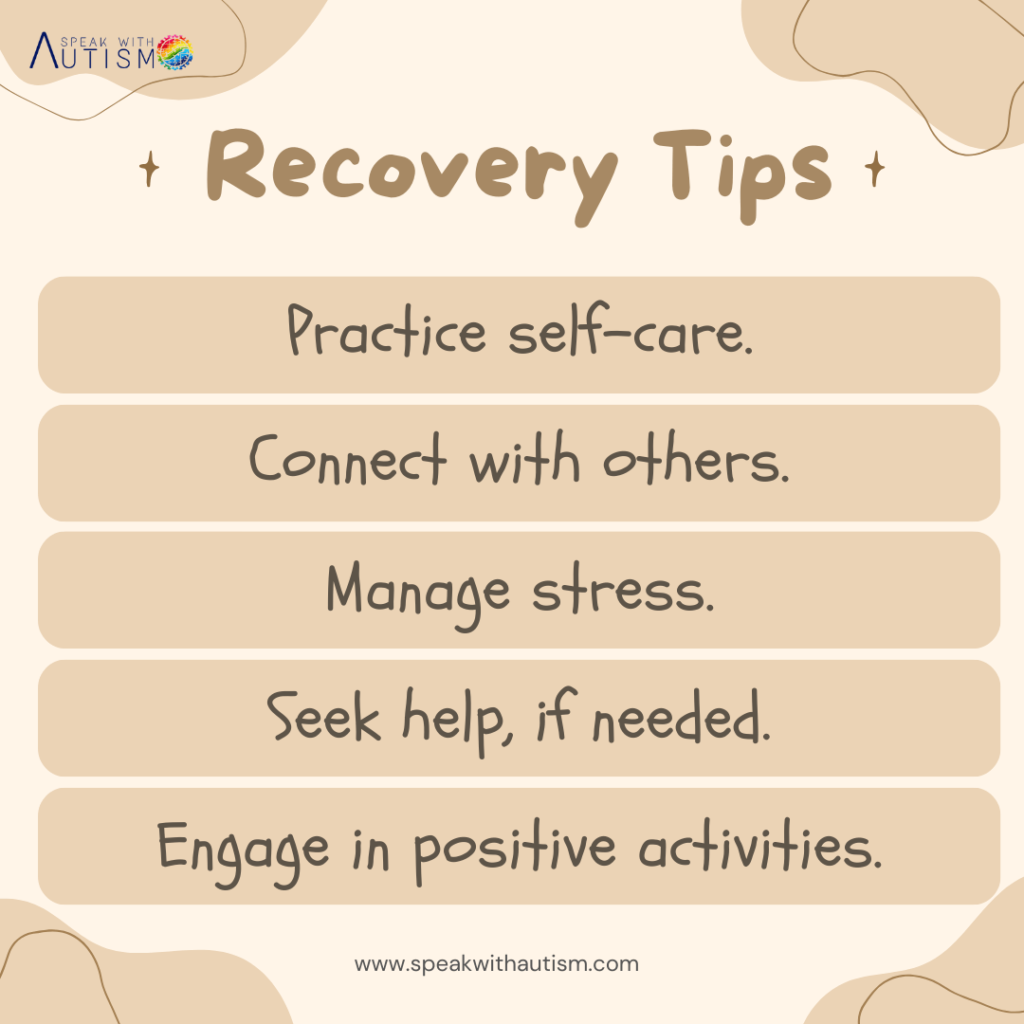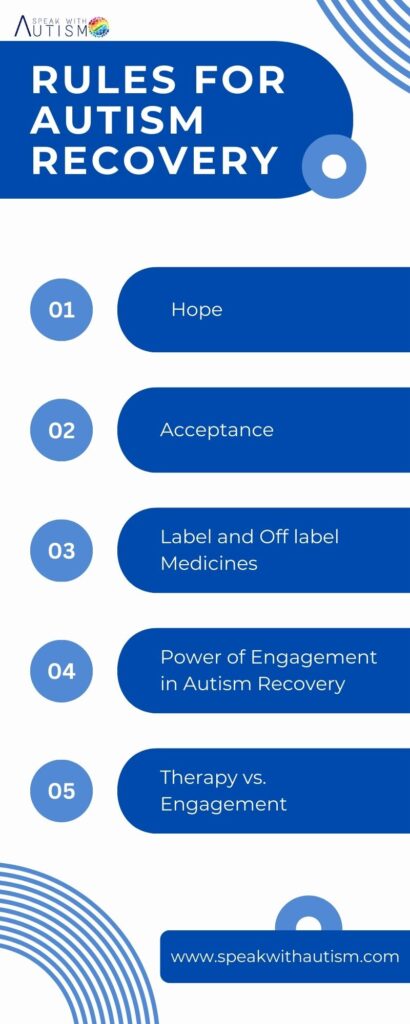Today we will discuss autism recovery and try to understand what are the golden rules that parents should follow if they hope for improvement and recovery in their children. We will also talk about cases that have already recovered – how recovery happened in those cases, what medicines were used, what therapy was used, what was the approach of the parents, and what should be the right attitude of the parents. Apart from this, at what age did they start working for recovery – we will discuss all these topics today.
Table of Contents

1. Hope (umeed)
When parents first come to know that their child is suffering from autism, the conventional medical system often takes away their hope. They are told that autism can never be cured. Friends, this is wrong!
I have seen from my own experience that some children recover from autism. Yes, it is true that autism is a difficult disorder and not every child recovers, but some children do recover. The first and most important step for recovery is to keep hope. If you lose hope, the journey ahead will become difficult.
Research:
- Research shows that in some cases the diagnosis of autism changes after 6-7 years of age.
- This means that there are always chances of improvement and recovery.
- So, the first golden rule of recovery is to keep hope and have a positive outlook towards recovery.
2. Acceptance (Swikriti)
The second important golden rule after hope is acceptance.
When parents accept their child’s autism early, they have more time to start treatment and therapy.
In the case of autism, there is a “rapidly closing window”, meaning the time for treatment is limited.
Disadvantage of Denial:
Many times parents waste time thinking about whether their child will be fine or it is just a speech delay. This denial reduces their child’s chances of improvement. Grandparents or extended family often try to make parents feel comfortable by saying, “It doesn’t matter, everything will be fine,” which wastes more time.
Key Takeaway:
- Getting a diagnosis early and accepting it is an important part of recovery.
- Without early intervention, the child’s condition can get worse.
3. Label and Off label Medicines
Autism treatment is broadly divided into two categories: Labeled Medicines and Off-Label Medicines. Neurologists typically prescribe Risperidone and Aripiprazole for severe irritability and aggression. However, when parents report specific issues like anxiety, hyperactivity, or sleep disturbances, neurologists often incorporate Off-Label Medicines to address these behaviors effectively.
These medications work by targeting neurotransmitters and brain chemicals, helping to regulate mood, reduce aggression, and improve focus and attention.
4. The Power of Engagement in Autism Recovery
Why Parental Engagement Matters
Friends, as soon as parents come to know that their child is facing challenges like autism, the first and most important step is to engage with them. Engagement means getting deeply involved in the child’s world. If your child is young, this requires spending quality time having fun and playing with them. Leaving the child with grandparents, a nanny, or neighbors will not work. The key to autism recovery is consistent and meaningful engagement from parents throughout the day.
The Role of Parents
Many parents, upon learning about their child’s autism diagnosis, immediately start searching for the best therapist in town. They move to different cities, live in challenging conditions, and spend significant money on therapies. Despite all these efforts, there’s often little improvement. Why? Because the best therapist for any child is the parent.
Therapies are important, but they are not a substitute for a parent’s involvement. Therapy and engagement aren’t rocket science. Engagement means connecting with your child through fun and interactive activities. Avoid going into “teaching mode” constantly. Instead, focus on play and connection, which are more natural and effective for development.
What Does Engagement Look Like?
Engagement is all about fun, connection, and creating a strong bond. Examples include:
- Playing games like hide-and-seek or catch.
- Running around together.
- Pillow fights.
- Singing songs and doing actions (e.g., “Ring-a-Ring-a-Roses”).
- Sharing laughter and spontaneous activities.
These playful interactions naturally connect your child to their environment. They help rebuild the learning mechanism that autism often disrupts. While neurotypical children learn from their environment automatically, children with autism need intentional engagement to reconnect with their surroundings.
Avoid Over-Teaching
Many parents fall into the trap of constantly teaching their children, expecting immediate results. For example, they might teach the child to identify colors or shapes and then ask, “What is this?” after a few days. When the child doesn’t respond as expected, frustration builds. This approach is counterproductive.
Teaching mode can create stress and behavioral issues, such as irritability or tantrums. Instead, focus on enjoyable, stress-free activities. Children learn best when they are relaxed and happy, not when they are pressured to perform.


5. Therapy vs. Engagement
While therapies can be beneficial, it’s crucial to monitor their impact. If your child cries or screams after therapy sessions or doesn’t want to go, it’s a sign that the approach might not be working. Therapy should be a positive experience, not something that creates fear or discomfort. Engagement through play, on the other hand, brings joy and fosters natural learning.
The Secret to Success
Engage, engage, and engage. From morning to night, keep your child involved in fun activities. Reconnect them with their environment through playful interactions. Remember, recovery is not about rigidly teaching children but about helping them rediscover the joy of learning and connection. This consistent effort from parents can lead to remarkable developmental progress over time.
So, friends, let’s prioritize engagement over teaching and create a loving, fun-filled environment for our children. Together, we can make a difference!
6. Therapy is not Rocket Science, simply have a lot of fun with the child
Fun-based learning is one of the best approaches you can adopt for your child with autism. But what exactly is fun-based learning? It means engaging in activities that bring joy to the child while helping them learn new things. It’s not about avoiding teaching but making learning so enjoyable that the child starts picking up lessons from their environment naturally.
For example, instead of reading a story in a typical way, you can use interactive tools like picture books with pull-out images or animal illustrations. Rather than reading a story while the child passively listens, bring it to life! Get down on your knees, act like a lion, and make lion and cat sounds. Say things like, ‘The lion ate the cat!’ Such animated activities will capture the child’s interest, and they will naturally enjoy the learning process.
Incorporate hands-on activities like sorting colored balls, threading beads, or identifying shapes, but make sure these tasks are enjoyable and engaging. While therapies like ABA (Applied Behavior Analysis) are effective, doing the same repetitive activities for long periods can become monotonous for the child. Fun-based learning complements therapy and promotes overall development.
7. Fun-based learning, the child should enjoy the engagement
Avoid the ‘negative effect’ of leaving the child disengaged after therapy sessions. When a child spends hours alone in their own world, it neutralizes the efforts made during therapy. To ensure progress, consistently engage the child throughout the day in fun and interactive ways that connect them with their surroundings.”
8. Parents’ Emotional Understanding and Supporting Your Child
Friends, I want to emphasize an important point: as parents, it is crucial to understand the emotions of your children. When parents learn that their child has autism, they often become very stressed. Their intentions are good, and they work hard to support their child. However, in many cases, this hard work takes a direction that negatively affects the child’s psychological state.
For instance, I have seen cases where a child was pressured to learn the alphabet. The child was crying while the parent insisted they complete ABCD before being allowed to move. In other cases, parents have resorted to strict methods, such as beating the child with a stick or scolding them harshly for not meeting expectations. This is not the right approach. Strict parenting and forceful teaching can harm the child’s emotional well-being.
It is essential to redefine how we approach our children. If your child is crying or showing unhappiness, it is a clear sign that the method being used is not suitable. Our children are already facing developmental challenges, and additional pressure can push them into a negative emotional state or even depression. A child in such a state cannot progress effectively.
Believe me, I have seen hundreds of cases where therapy or parental pressure caused children to regress emotionally. Friends, your intentions are pure and filled with love, but finding the right way to support your child is equally important. Always ensure your child feels happy and secure.
9. Managing Hyperactivity in Children with Autism
In autism, 90 to 95% of children exhibit hyperactivity. This is a significant challenge as hyperactivity makes it difficult for children to concentrate, connect with their environment, or engage in therapy sessions effectively. One major factor contributing to hyperactivity is sugar consumption.
Sugar doesn’t just come from the sugar added to milk or tea. Biscuits, toffees, fruit juices, and even sweet fruits contain sugar, which adds to the overall daily intake. Most parents unknowingly give their children excessive amounts of sugar, which exacerbates hyperactivity and creates a significant block in the child’s recovery.
To manage this, parents must carefully calculate and reduce their child’s total sugar intake. opt for healthier alternatives like nuts, unsweetened snacks, or low-sugar fruits. Keeping sugar levels in check will help reduce hyperactivity and make therapy sessions more effective.
10. Make your home Therapy Center/School

We commonly see that as soon as parents find out their child has autism, they enroll them in a nearby school. However, friends, this approach can often be counterproductive—meaning it may cause more harm than good. Let me explain why this happens.
Parents often say, “The child is only going to school for one or two hours. What harm can it do? If they spend time with other children, they might improve quickly.” But, friends, it’s not just one or two hours. Look at the bigger picture:
- In the morning, you wake the child up early, prepare them, and drop them off at school. By the time they return home, eat, and rest, it’s already afternoon. When they wake up again, it’s evening—most of the day is gone.
- This leaves very little time for active therapies or focused engagement, which are far more important for your child at this stage.
- Schooling at this point is not a necessity, but rather a decision driven by parental anxiety or societal pressure.
- Instead of rushing into schooling, the priority should be to create an environment where the child can truly thrive.
Therapy Centers: A Key Consideration
If you’re opting for a therapy center, make sure:
- The center is close to your home to avoid long hours of travel. If you’re spending 3-4 hours commuting daily (as often happens in metro cities), it’s counterproductive for the child.
- The child is happy and learning effectively at the center. If you find it’s not adding value, rethink this choice.
Transform Your Home into a Therapy Space
Your home can become the best therapy center for your child. Leverage the resources and people around you:
- Family members like grandparents, relatives, and siblings can play an active role in engaging with the child.
- Spend quality time working with your child throughout the day.
- Create a structured routine with activities that help the child grow and connect with their environment.
Conclusion
Friends, these are my 10 golden rules. I wish you all the best in helping your children progress. If you ever need assistance, feel free to email us.
Frequently Asked Questions (FAQ)
Can Autism be cured?
Autism is a developmental disorder that affects the development and functioning of the brain. It is a lifelong condition, and currently, there is no known cure. However, with early intervention therapies and consistent parental support, autistic children can make significant progress, learn essential life skills, and achieve a high degree of independence.
In some cases, though, autism may not fully resolve, and individuals may continue to experience challenges associated with the autism spectrum throughout their lives. This means the idea of completely “curing” autism or making it “disappear” does not have a scientific basis.
Instead, with the help of targeted therapies and effective management strategies, autistic individuals can reach their maximum potential and lead fulfilling, independent lives to the best of their abilities.
Is therapy necessary for the child or can autistic children recover by engaging in it at home?
Therapies are very important for autistic children as they are scientifically designed to work on their specific challenges. Early intervention therapies such as Occupational Therapy, Speech Therapy, ABA Therapy (Applied Behavior Analysis), and Sensory Integration Therapy help a lot in their overall development. These therapies improve their communication, behavior, and sensory processing issues.
But the role of parents at home is also very important. If parents understand the sensory and developmental needs of their children and engage them, it has a positive impact. Simple activities such as push-pull games, sensory play (sand, water, clay), calming music, and involvement in daily routines help the child improve. A collaborative approach between parents and therapists is most effective for the child’s recovery and independence.
This means that the child will not recover with activities at home alone, but if therapies and home activities are combined, the child’s progress can be very good.
What to do if your child cries a lot during therapy time?
If your child cries during therapy, first try to understand the reason for his or her discomfort, such as sensory overload or difficulty with the activity. Give feedback to the therapist and ask him or her to make activities interesting and fun.
Include favorite things (toys, songs, snacks) in therapy sessions and give short breaks if necessary.
Introduce activities gradually and encourage the child through positive reinforcement.
Parental involvement helps the child feel calm and supported during therapy.
Praise every small progress and keep the routine consistent.
Try to vary the therapy with games and playful activities. If problems persist, modify the focus of the session with the therapist. With patience and love, the child will gradually accept the therapy and begin to enjoy it.
If the therapist says that children cry during therapy, is it true?
If you say your child cries during therapy, it’s important to understand why this is happening. All children initially do this when they are faced with new experiments or unwanted activities, but this isn’t always wrong.
Therapy is designed to improve the child’s skills and development, but if the child is constantly being bullied, a few things should be checked:
Focus of therapy: Are the therapist’s activities being modified according to the child’s needs and interests?
Sensorial overload: Is the environment too noisy and overwhelming to avoid?
Level of activity: What activity is more challenging than the rest?
Participation of the parents: Does therapy support the child during therapy?
The therapist will discuss with you about alternative strategies and plans. If the child is doing well gradually, therapy is beneficial, but if the stress is severe, it may be necessary to adjust the therapy.
